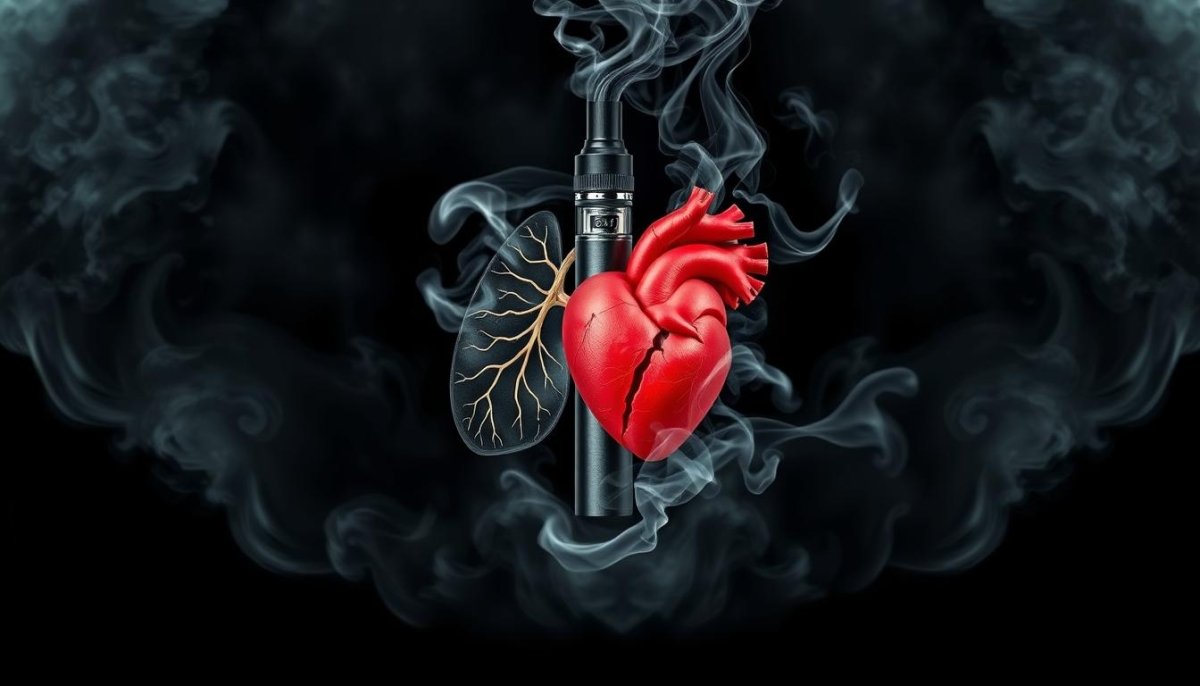Dangerous Side Effects of Vaping: What to Know

Dangerous Side Effects of Vaping: What to Know
Vaping is getting more popular in the UK, but it comes with serious side effects. Jane, a health-aware professional in her 30s, thought vaping was safer than smoking. But, she soon found out it wasn't.
Jane started feeling chest pains and shortness of breath. She went to the doctor, who told her vaping had damaged her lungs. This news shocked her and made her understand the risks.
Jane's story warns us about vaping's dangers. It can cause breathing problems, heart issues, and affect mental health. We'll explore these risks to help you make better choices for your health.
Key Takeaways
- Vaping can lead to serious health issues, like lung damage, heart problems, and mental health concerns.
- The long-term effects of vaping are still unknown, but evidence suggests it can harm your health.
- Young people who vape risk becoming addicted to nicotine.
- Exposure to vaping can also harm people nearby, making it a public health issue.
- Rules and safety standards for vaping products are still changing, so be cautious and informed.
Understanding Vaping: An Introduction
Vaping, also known as electronic cigarettes or e-cigarettes, has quickly become popular in the UK. This new technology has changed how people use nicotine and find alternatives to smoking.
What is Vaping?
Vaping uses a battery-powered device to heat a liquid solution, called e-liquid or e-juice. This liquid often has propylene glycol, vegetable glycerin, nicotine, and flavourings. When you inhale this vapour, it feels like smoking, but without the harmful tar and smoke.
The Rise of Vaping in the UK
The UK has seen a big increase in vaping in recent years. Action on Smoking and Health (ASH) reports that vaping numbers have grown from 700,000 in 2012 to over 3.6 million in 2022. This rise is due to vaping being seen as safer, the variety of flavours, and easier access to vaping products.
| Year | Number of Vapers in Great Britain |
|---|---|
| 2012 | 700,000 |
| 2022 | 3,600,000 |
The growth of vaping in the UK is also linked to the country's vaping regulations. The UK has been more open to vaping as a way to help smokers quit traditional cigarettes.
"Vaping has become a popular way for people in the UK to move away from traditional tobacco cigarettes, and the industry has responded by offering a wide range of products and flavours to cater to this growing demand."
Health Risks Associated with Vaping
Vaping is becoming more popular, but health concerns are growing too. It's important to look at the science behind vaping's effects. We need to understand both the short-term and long-term risks.
Short-term Health Effects
Vaping can cause immediate problems like throat and mouth irritation. It can also lead to a dry cough and nausea. Some people experience headaches, dizziness, and a faster heart rate after vaping.
Long-term Health Implications
The long-term effects of vaping are still being studied. But, research shows it might cause serious lung problems. This includes lung inflammation and a condition called "popcorn lung." Vaping could also raise the risk of heart disease and high blood pressure.
The chemicals in e-liquids, like diacetyl and formaldehyde, are worrying. These substances can harm health. The full impact of breathing them in is still unknown, but the risks are clear.
"The potential for vaping to cause long-term damage to the lungs and cardiovascular system is a serious concern that cannot be overstated."
As vaping evolves, it's key to know the vaping health risks. Making informed choices about health is crucial. By staying informed and looking for reliable sources, vapers can make better decisions.
Chemical Composition of E-liquids
The vaping industry is growing fast. It's key to know what's in e-liquids. These solutions in electronic cigarettes mix many ingredients. These can affect users' health a lot.
Common Ingredients in E-liquids
E-liquids mainly have propylene glycol and vegetable glycerin. These make the vapour. Other things in them are:
- Nicotine, for a buzz
- Flavourings, like fruit or mint
- Solvents, like ethanol or water, to thin it out
Toxic Substances Found in Vaping Products
Even though e-liquids are seen as safer than cigarettes, some have harmful chemicals. These include:
- Formaldehyde, a cancer-causing agent, from overheating
- Diacetyl, linked to lung disease
- Heavy metals, like lead, from the heating coils
It's not clear how these chemicals affect health over time. But, it shows we need to check what's in e-liquids and vaping products.
Respiratory Issues Linked to Vaping
Vaping has become very popular, but it's causing big worries about lung health. Many studies show vaping can harm the lungs a lot. This has led to more cases of vaping lung injury and other breathing problems.
Effects on Lung Health
Vaping can cause many lung issues, like inflammation and damage. It can even lead to "popcorn lung." The chemicals in e-liquids, like propylene glycol and vegetable glycerin, can hurt the lungs. This can make breathing harder and reduce lung function.
Symptoms of Vaping-related Respiratory Problems
- Cough
- Shortness of breath
- Chest pain
- Wheezing
- Nausea and vomiting
- Fever
- Weight loss
These symptoms can be mild or get worse over time. If not treated, they can lead to serious lung problems. In some cases, vaping can cause a dangerous lung injury called EVALI.
Why vaping harms the lungs is still being studied. But, it's thought that chemicals, heavy metals, and inhaling heated aerosols play a role. As vaping grows, it's important for users to know about the lung risks.
Cardiovascular Effects of Vaping
Research shows vaping can harm heart health. As e-cigarettes grow in popularity, knowing the vaping heart risks and e-cigarette cardiovascular effects is key.
Impact on Heart Health
Studies link vaping to heart problems. E-cigarettes can raise blood pressure, heart rate, and stress markers. Nicotine and other chemicals in e-liquids harm the heart and blood vessels.
Some research points to higher risks of heart attacks and serious heart events. The exact ways vaping harms the heart are still being studied. But, it's clear vaping is risky, especially for those with heart issues.
Vaping and Blood Pressure Concerns
Vaping's impact on blood pressure is a major worry. Many studies show e-cigarettes can temporarily increase blood pressure, like cigarettes. This is dangerous for people with high blood pressure or heart conditions.
Long-term vaping might also lead to lasting high blood pressure. This is a big risk for heart disease, stroke, and other serious health issues. It highlights the need for more research into e-cigarette cardiovascular effects.
As scientists delve deeper into vaping's heart risks, staying informed is vital. Understanding vaping heart risks helps vapers protect their health. They can take steps to reduce their exposure and focus on their well-being.
Vaping and Mental Health
Vaping is getting more popular, but it raises concerns about mental health. Research shows that vaping addiction and nicotine dependence might increase anxiety and depression risks.
Anxiety and Depression Risks
Studies have found that e-cigarette users face higher anxiety and depression symptoms than non-users. Nicotine's addictive nature plays a big role in these mental health issues.
Nicotine messes with the brain's balance, causing mood swings and trouble focusing. This can worsen mental health or even start new problems, like e-cigarette mental health issues.
Addiction and Dependence on Nicotine
- Vaping devices give high doses of nicotine, making it hard to stop using.
- Vaping's ease and secrecy can make vaping addiction harder to break.
- Quitting can lead to withdrawal symptoms like anxiety and depression, keeping users hooked.
Dealing with vaping's mental health effects needs a broad strategy. This includes education, treatment, and understanding the link between e-cigarette mental health and nicotine addiction.
"Vaping may seem like a safer alternative to smoking, but the mental health risks associated with nicotine addiction should not be overlooked."
Oral Health Consequences of Vaping
Vaping can harm your lungs and heart, but it also affects your teeth and gums. Research shows vaping can lead to gum disease and tooth decay. These are serious problems.
Gum Disease and Tooth Decay
Vaping can make your gums more likely to get gum disease and tooth decay. The chemicals in e-liquids, like propylene glycol, can irritate your gums. This can cause inflammation and make you more prone to gingivitis.
Vaping also lowers saliva production. Saliva helps clean your mouth and protect your teeth. Without enough saliva, your teeth and gums are more at risk of cavities and other problems.
The Effect on Saliva Production
Vaping can make your mouth dry, a condition called xerostomia. Saliva is key for a healthy mouth. It helps neutralise acids and wash away food. Without enough saliva, you're more likely to get cavities and gum disease.
Also, e-liquids often have a lot of nicotine. This can make your mouth even drier and feel sticky.
"Vaping poses a significant threat to oral health, with the potential to increase the risk of gum disease, tooth decay, and other dental problems. It's crucial for vapers to be aware of these risks and take steps to minimise the impact on their oral hygiene."
The evidence is clear: vaping can harm your oral health. It's important to see a dentist and think about safer options than e-cigarettes.
Vaping Among Adolescents and Young Adults
The youth vaping epidemic is a big worry in the UK. More and more teens are using e-cigarettes. This is very bad for their health.
Statistics on Youth Vaping
Studies show that more young people in the UK are vaping. In fact, almost one in five secondary school students have tried e-cigarettes. This is very scary because we don't know how vaping affects growing bodies and brains.
Consequences of Early Exposure
Starting to vape early can lead to big problems. Nicotine addiction, changes in the brain, and a higher chance of smoking regular cigarettes are some risks. It can also cause breathing and heart issues, and even affect mental health.
| Age Group | Percentage of Vapers |
|---|---|
| 11-15 years old | 4.9% |
| 16-18 years old | 19.6% |
| 19-21 years old | 25.2% |
The rise in youth vaping is very worrying. We need to teach them, make rules, and help them to stop. Keeping young people healthy is very important in fighting this problem.
Secondhand Vaping Risks
Vaping is seen as safer than smoking, but secondhand vaping risks are real. Exposure to e-cigarette vapour can harm bystanders. This is known as secondhand vaping or e-cigarette passive exposure.
Understanding Secondhand Exposure
Secondhand vaping happens when people breathe in vapour from e-cigarettes. This vapour can have harmful chemicals like nicotine and flavourings. These can affect people nearby.
Health Risks for Bystanders
- Exposure to nicotine: Nicotine in vapour is a big worry for kids and pregnant women. It can harm their health and growth.
- Respiratory issues: Vaping vapour can irritate lungs and airways. This might cause breathing problems for bystanders.
- Cardiovascular concerns: The chemicals in vapour can also harm heart health. This increases the risk of heart problems.
Vapers should think about how their vaping affects others. Being careful and vaping responsibly can reduce risks. This includes not vaping indoors and keeping a safe distance from others.
| Potential Health Risks of Secondhand Vaping | Impact on Bystanders |
|---|---|
| Nicotine exposure | Adverse effects on health and development, particularly for vulnerable populations |
| Respiratory irritation | Breathing difficulties and other respiratory problems |
| Cardiovascular concerns | Increased risk of heart-related issues |
Knowing the risks of secondhand vaping helps people make better choices. It's about considering how vaping affects those around us.
Regulatory Environment and Safety
The vaping industry is growing fast in the UK. It's key to know the rules and safety standards for these products. The UK has strict vaping laws to keep consumers safe and ensure e-cigarettes and e-liquids are safe.
Overview of UK Vaping Regulations
In the UK, vaping products fall under the Tobacco and Related Products Regulations 2016. These rules cover how e-cigarettes and e-liquids are made, packaged, and marketed. Manufacturers must follow strict guidelines, like limits on nicotine, ingredient lists, and quality checks.
- All e-cigarette and e-liquid products must be notified to the Medicines and Healthcare products Regulatory Agency (MHRA) before they can be sold in the UK.
- Advertising and promotion of vaping products are subject to specific rules to prevent targeting of minors.
- E-cigarette users must be at least 18 years old to purchase and use these products.
Safety Standards for E-liquids
The UK's vaping laws also focus on e-liquid safety. Manufacturers must follow these standards:
- Nicotine content is limited to a maximum of 20 milligrams per millilitre (mg/ml).
- Ingredients used in e-liquids must be of high purity and pharmaceutical grade, with no prohibited substances.
- Strict labelling requirements, including warnings about the addictive nature of nicotine and the risks of using these products.
- Comprehensive testing and quality control measures to ensure the safety and consistency of e-liquid products.
By following these rules, the UK aims to offer a safer option for adult smokers. It also works to protect public health and stop young people from using vaping products.
Alternatives to Vaping
Many smokers are looking for safer ways to quit vaping due to health concerns. Luckily, there are several smoking cessation products and harm reduction strategies that can help. These alternatives can make it easier to move away from traditional cigarettes.
Smoking Cessation Products
Nicotine replacement therapies (NRTs) like patches, gums, and lozenges are recommended by doctors. They give nicotine without the harmful chemicals in tobacco smoke. This helps reduce cravings and withdrawal symptoms.
Prescription drugs like varenicline and bupropion also help smokers quit. They make nicotine less enjoyable and ease withdrawal symptoms. These medicines can be a big help for those trying to quit smoking for good.
Other Harm Reduction Strategies
- Switching to heated tobacco products can reduce harmful chemicals compared to regular cigarettes.
- Nicotine pouches offer a nicotine-based alternative to smoking and vaping.
- Physical activity, mindfulness, and joining support groups can also help in the vaping alternatives and smoking cessation journey.
Exploring these vaping alternatives and smoking cessation options can help smokers find what works best for them. This can lead to a reduction in the harmful effects of nicotine addiction.
Public Perception of Vaping Risks
The way people see vaping risks is often wrong. This is because of myths and media influence. Many still think vaping is unsafe, even with scientific proof. We will look at vaping myths and how the media affects what people think.
Misconceptions about Vaping Safety
Many believe vaping is as bad as smoking. This is because of scary media stories and not knowing the facts. But, vaping is seen as safer because it doesn't have the harmful stuff found in cigarettes.
Some think vaping leads to smoking, especially for the young. While some studies link vaping to smoking, it's not clear if it causes it. We need to understand addiction and why people might start smoking.
The Role of Media in Shaping Views
The media has a big part in how we see vaping risks. Bad news about vaping can make people scared and distrustful. This can hide the good things vaping can do for smokers.
Also, the media likes to make health issues seem simple and scary. It's important to be careful and look for real, trustworthy information.
"The public perception of vaping is often shaped more by media narratives than by scientific evidence." - Dr. Sarah Jones, Public Health Researcher
By clearing up these myths and knowing how the media works, we can make better choices about vaping. This helps us understand vaping better, beyond just myths.
The Future of Vaping Trends
The vaping world is set for big changes. Experts predict new e-cigarette tech and rules will shape vaping's future. These changes will come from better device designs and new laws.
Evolving Technology in Vaping Devices
Vaping fans can look forward to exciting new tech soon. Makers will work on making vaping better, with longer battery life and cool features. Expect "smart" devices that track your vaping and connect with phones.
Also, expect smaller, easier-to-use vaping devices for those who vape less often. New e-liquids, like nicotine salts, will likely make vaping even better.
Predictions for Vaping Regulation
Regulators will keep a close eye on vaping as it grows. They'll focus on making products safer, with stricter rules for e-liquids and how they're made. There might be more labels and info to help users make informed choices.
The role of vaping in helping people quit smoking will also be a big topic. Lawmakers will try to find a balance between vaping's benefits and concerns about young people and health risks.
In the end, vaping's future will depend on tech, what people want, and rules. These factors will greatly influence the vaping industry's path.
Tips for Vapers to Minimise Risks
Vaping carries risks that need to be understood and managed. For those already vaping, it's key to focus on health and safety. By following safe vaping practices and making smart choices, users can lessen the harm from e-cigarettes.
Choosing Safer Products
Choosing the right e-cigarettes and e-liquids is critical. Look for products that meet the UK's high safety standards. Check the ingredients, nicotine levels, and any additives in e-liquids. Also, choose devices with safety features like temperature control and overcharge protection.
Practising Responsible Vaping
Responsible vaping habits are also important. Avoid vaping in enclosed public areas to prevent secondhand exposure. Keep your device clean and replace coils regularly. Also, be careful with nicotine intake and try to reduce it over time.
By focusing on safe vaping and making smart choices, users can reduce risks. This helps protect their health and well-being.
Resources and Support for Vapers
If you're looking for help with vaping or e-cigarette addiction, the UK has many resources. You can find support to quit vaping or just cut down. These options offer guidance and a community to help you.
Where to Find Help
Struggling with vaping addiction? There are professional services ready to help:
- National Health Service (NHS) Stop Smoking Services - Get free, tailored support to quit smoking and vaping.
- Quit Right UK - A helpline and online programme for vapers and e-cigarette users.
- Local stop smoking clinics - Find one-on-one support and nicotine therapy to quit.
Community Support Networks
There are also vaping communities in the UK for peer support:
- Online forums - r/electronic_cigarette and Vaping.com Forums are great for sharing and getting tips.
- Local vape shops - Meetups and events create a space for vapers to support each other.
- Social media groups - Facebook, Twitter, and more have vaping support resources and e-cigarette addiction help groups.
Using these vaping support resources and connecting with others can help you quit vaping.
Conclusion: Making Informed Decisions
Exploring the dangers of vaping shows how important it is to make smart health choices. E-cigarettes and vaping products can harm our lungs, hearts, and minds. It's time to take action to protect our health.
Reflecting on the Risks of Vaping
This article shows we need to understand vaping's long-term effects. E-liquids can contain harmful chemicals, and vaping can lead to serious illnesses. Vapers should think carefully about the risks and weigh them against any benefits.
Encouraging Open Conversations About Health
We must talk openly about vaping's dangers. Doctors, lawmakers, and everyone should discuss the risks. This way, we can help people make choices that keep them healthy.
FAQ
What are the side effects of vaping?
Vaping can cause many health problems. These include breathing issues, heart problems, and mental health issues. Long-term vaping can damage lungs, increase heart disease risk, and lead to nicotine addiction.
What are the long-term health implications of vaping?
Vaping's long-term effects are still being researched. But, it may cause serious health issues. These include chronic lung diseases, heart problems, and even brain issues, especially in young people.
What are the common ingredients in e-liquids?
E-liquids usually have propylene glycol, vegetable glycerin, nicotine, and flavorings. But, some contain harmful substances like formaldehyde and acrolein. These can harm your health when inhaled.
How does vaping affect lung health?
Vaping can lead to lung injuries, known as EVALI. Symptoms include coughing, shortness of breath, chest pain, and acute respiratory distress syndrome (ARDS).
Can vaping lead to heart health issues?
Yes, vaping can harm your heart. It increases the risk of heart attack, stroke, and high blood pressure. The chemicals in vaping products can affect your heart and blood vessels.
Does vaping affect mental health?
Research shows vaping may cause mental health issues. These include increased anxiety and depression. Nicotine in e-cigarettes can also lead to addiction and withdrawal symptoms.
What are the risks of vaping for young people?
Vaping is especially risky for teens and young adults. Their brains are still growing. Nicotine and other chemicals in e-cigarettes can harm brain development, leading to addiction and cognitive problems.
What are the potential risks of secondhand vaping exposure?
Secondhand vaping vapour can harm others. It contains chemicals and particles that can be inhaled by bystanders. Non-users may experience respiratory irritation, increased infection risk, and other health issues.
What are the current regulations on vaping in the UK?
In the UK, e-cigarettes and e-liquids are regulated by the Tobacco and Related Products Regulations 2016. These rules ensure vaping products are safe and of good quality. They include limits on nicotine and requirements for ingredient labelling.
What are some alternatives to vaping for those looking to quit smoking?
In the UK, there are many ways to quit smoking. Options include nicotine replacement therapy (NRT) like patches, gum, and lozenges. Prescription medications like varenicline and bupropion are also available. These alternatives may be safer and more effective than vaping for quitting smoking.






